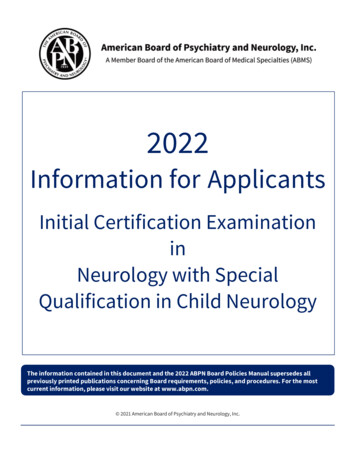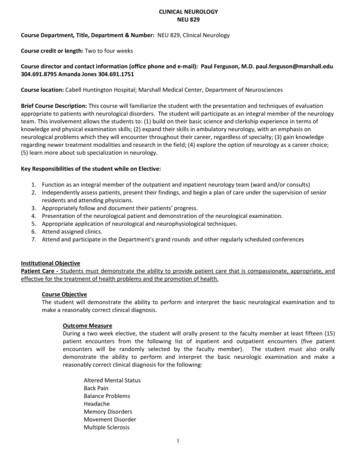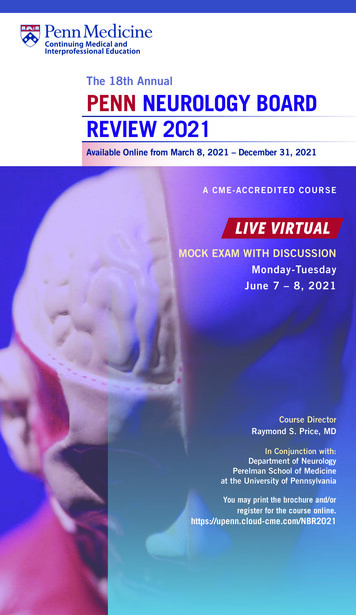
Transcription
Continue
Blueprints neurology 5th edition pdf download books online freeThis syrinx is associated with a type I Chiari malformation characterized by the downward displacement of the cerebellar tonsils through the foramen magnum (small black arrow). Coordination and gait may be tested in patients who are arousable enough. c (Chapter 8) 99. One might not be able to recognize that a speaker of a foreign language had aWernicke’s aphasia, because all but the content of language would be intact. Unlike patients with Broca’s aphasia, those with Wernicke’s aphasia seem unaware of their deficit initially and can become quite angry or paranoid when it becomes obvious that others have difficulty understanding them. The patient with complex partial seizures maywander or make semipurposeful movements; if necessary, he or she should be gently guided out of harm’s way. Alexander disease Glial fibrillary acidic protein 11 or 17, autosomal recessive Rosenthal fibers on biopsy. The distal latency, compound muscle action potential (CMAP), and conduction velocity are recorded. The tumor is displacing andcompressing the ventricular system. Choices A through C are all measures that acutely decrease ICP, while neurosurgery may be needed as a more definitive intervention. Most ischemic strokes in diabetic patients are due to intracranial small vessel disease (lacunar stroke). Calcium-channel blockers are often used to minimize vasoconstriction anddelayed brain ischemia. Wernicke’s encephalopathy is characterized by the clinical triad of ophthalmoplegia, (truncal) ataxia, and confusion developing over a period of days to weeks. Vein of Galen 80. 5-2) are often quite intimidating for students, but it need not be, because—ironically—it is their complex anatomy that makes localizing lesions to aplexus more straightforward than expected. INTERPRETATION OF RESULTS CSF is a clear, colorless fluid. DRUG-INDUCED MOVEMENT DISORDERS Drugs with dopamine receptor–blocking activity have a particular propensity for inducing a variety of movement disorders, including akathisia, acute dystonic reactions, parkinsonism, tardivedyskinesia, and the neuroleptic malignant syndrome. 11 e. A 28-year-old man was recently diagnosed with obstructive sleep apnea. The virus can produce an encephalitis and also makes the individual susceptible to CNS infections such as toxoplasmosis, tuberculosis, and syphilis, which can cause dementia as well. Anaplastic (malignant) astrocytoma(WHO grade III) 3. Scammell TE. 13. Most abnormalities of the nervous system manifest themselves in ways visible to the observant examiner. Although somewhat less accurate than MRA or conventional angiography, Doppler studies are noninvasive and virtually without contraindication. The risk is reduced with alternate-day regimens.Radiculopathy, especially thoracic, occurs with greater frequency in diabetic patients. No specific treatment is available. Optic chiasm b. The ataxia is due to proprioceptive loss rather than to cerebellar dysfunction. KEY POINTS TICS Tics are abrupt, stereotyped, coordinated movements or vocalizations. Xanthochromia indicates recent intrathecalhemorrhage. 12887 CH05.qxd 10/4/08 3:18 PM Page 44 44 Blueprints Neurology NERVE ROOT DISORDERS Pattern of Weakness Each nerve root relevant to the upper or lower extremity exits the spinal cord and eventually traverses a plexus (either brachial or lumbosacral) in which its fibers separate and become part of multiple differentperipheral nerves, which then go on to innervate multiple different muscles. Left cerebral hemisphere strokes lead to: a. ALS/Riluzole Study Group. Diagnosis may be confirmed by demonstrating increased copper staining on liver biopsy. The prognosis is uncertain but often poor. .145 22 Disorders of the Spinal Cord . It is administered intravenouslyand the patient observed for improvement in muscle strength. When ballism is severe, contralateral thalamotomy or pallidotomy may be beneficial. Hypesthesia 34. As noted previously, listening to the patient tell their history may be all that is necessary to gauge language ability. The lateral (L) region is at the same level of the pons; its stimulationproduces a powerful contraction of the urethral sphincter (storage). Schwannoma (neurinoma, neurilemoma) 2. MRI shows T2-hyperintensities, usually in the parietal and occipital regions. When examined in the emergency room, she is found to have rotatory and downbeating nystagmus during the Dix-Hallpike maneuver with the head tilted one waybut not the other. Intravenous ceftriaxone c. Leaning and veering while sitting or walking, with gait ataxia g. 12887 CH15.qxd 10/4/08 3:26 PM Page 110 110 Blueprints Neurology ANTIEPILEPTIC DRUGS AND PREGNANCY PSYCHOGENIC NONEPILEPTIC SEIZURES Women taking AEDs have a somewhat higher risk of fetal malformations thanthe general population, though the absolute risk is still low. Systemic findings include cataracts, ptosis, arrhythmias, dysphagia (from esophageal myotonia), insulin resistance, testicular atrophy, and frontal balding. Arms should thrust forward symmetrically as if breaking the fall. The sensory loss is described as “dissociated” because pain andtemperature sensation is affected, but touch and position sense is not. The pain is typically excruciating, and affected individuals are often restless and feel the need to be up and moving around (in contrast to patients with migraine who prefer to lie still in a quiet, dark place). More toxic immunosuppressants are often used in refractory cases.Pathologic or acquired nystagmus Periodic alternating nystagmus Horizontal jerk nystagmus that changes direction every 2 to 3 minutes. KEY POINTS A radiculopathy causes weakness in the muscles innervated predominantly by fibers from one nerve root. Others include headache, dyspepsia, dizziness, and urinary tract infections 2. Radiation orchemotherapy can be used depending on other prognostic factors. It occurs predominantly in young women, and neurologic involvement is common. Residents studying for USMLE Step 3 often use the books to review areas that were not their specialty. (Reproduced with permission from Armstrong P, Wastie M, Rockall A. KEY POINTS Hypotoniacan be central, peripheral, or both. 5-4) explains why lesions in the parasagittal part of the cerebral hemisphere cause weakness primarily in the leg, whereas lesions more laterally in the hemisphere cause weakness primarily in the face and arm. Urinary and sexual dysfunction may also occur. Emboli most often come from the heart, aorta, andproximal portions of the neck or intracranial arteries. a (Chapter 14) 41. TENSION-TYPE HEADACHE Tension-type headache is the most common form of headache. Head imaging is usually needed even in these cases of suspected diffuse cause because it may demonstrate signs of global hypoxic-ischemic injury, diffuse cerebral edema, or bilaterallesions mimicking a diffuse 12887 CH03.qxd 10/4/08 3:17 PM Page 26 26 Blueprints Neurology process, although the urgency is not as high as for patients with focal findings. Several common patterns of abnormal activity are recognized. Most emergency rooms (ERs) make it standard practice to administer naloxone, thiamine, and dextrose to anypatient with depressed consciousness and no obvious etiology. A 22-year-old right-handed woman develops horizontal diplopia acutely. 5-3). Clinical Manifestations “Doctor, my mother is 75 years old and over the last 3 years I have noted that she is having more difficulty with her memory. Waddling gait suggests proximal muscle (hip girdle)weakness. MS is more common in women and more common in whites. With psychogenic leg weakness, for example, the patient tends to drag her leg behind or push it ahead of her. e (Chapter 20) Intravenous corticosteroids may delay but not prevent the development of MS in a patient with optic neuritis. Other clinical features characteristic of MSinclude Lhermitte’s sign, a tingling, electric sensation 12887 CH20.qxd 10/4/08 3:30 PM Page 141 Chapter 20 / Demyelinating Diseases of the Central Nervous System 141 down the spine when the patient flexes the neck, and a worsening of symptoms and signs in the heat, termed Uhthoff’s phenomenon. His 14. However, for a monthly fee orannual subscription, you can receive physical books in the mail and access educational printables. Confrontation testing is subjective and variable; the grading of muscle strength depends on the examiner’s effort and expectations of what the patient’s “normal” strength should be. Episodes of chronic paroxysmal hemicrania typically last for 20minutes rather than hours. A very high IgM anti-GM1 is found in 60% to 80% of patients with MMN. Visual memory can be tested with three simple shapes for the patient to draw from memory in several minutes. Radiculopathy refers to involvement of nerve roots (Table 23-4). This generates an inward sodium current through the acetylcholinereceptor ion pore, which leads to depolarization of the muscle endplate. The motor and vocal tics may change over time. More information can be gained by giving longer lists of words and charting the patient’s learning (and forgetting) curve. The brain and spinal cord are protected from external forces by the surrounding bones (the skull andvertebrae), and by the meninges, particularly the tough, resilient connective tissue of the dura mater. Epilepsy is a clinical diagnosis; interictal epileptiform EEG findings are demonstrable in about half of patients with epilepsy. Other areas that contribute to saccadic control include the dorsolateral prefrontal cortex, supplementary eye field, andparietal lobe. 15-3). On the contrary, an orderly and hypothesis-based approach may be even more important in a comatose patient than in others, given the need for timely diagnosis and the relative limitations on history and examination. Remember the ABCs. In any patient with altered consciousness, the airway, breathing, and circulation should bechecked and maintained according to usual protocols, including intubation and mechanical ventilation if required. 25. Nausea and vomiting need not be present, especially in the early stages of a tumor. The inheritance pattern is X-linked. The clinical presentation includes an acute confusional state, spastic quadriparesis, locked-in syndrome,dysarthria, and dysphagia. There are essentially two neurologic varieties of syncope, both involving some dysfunction of the autonomic nervous system that results in excessive vasodilation. The neuropathy is distal and symmetric, with a stocking-glove distribution. Triptans (drugs that are agonists of the 5-hydroxytryptamine 1B, 1D, and 1Freceptors) are the mainstay of therapy, and these are available in several formulations (oral, sublingual, nasal, and subcutaneous). It is almost always bilateral. Urge incontinence is an involuntary loss of urine associated with a strong desire to void (urgency), usually associated with detrusor instability (DI). Amyotrophic lateral sclerosis causesdegeneration of both the corticospinal tracts and anterior horn cells. A PCR assay of the CSF is available for spirochetal antigen. Symptoms may start when the tumor has grown substantially. Table 25-2 gives a brief description of primitive reflexes and their significance. Treatment depends on the number of metastases, the immediate mass effect ofthe lesion, and the general status of the patient. Nerve damage produces sensory problems in the distribution of the damaged nerve; root damage produces sensory problems in a dermatome; and plexus damage produces sensory problems in a group of nerves in the same limb. In the alien-limb phenomenon, patients retain awareness of the limb butfeel that it is not under their control. Antibody-associated polyneuropathy syndromes: principles and treatment. Which of the following statements concerning this disorder is true? Symptoms usually begin with stiffness of the axial and trunk muscles, with spread to the proximal limb muscles over time. 8th ed, Oxford: Blackwell Publishing, 2005:113.)SPINAL EPIDURAL ABSCESS Clinical Findings Spinal epidural abscesses typically present with the combination of neck or back pain and focal neurologic signs consistent with spinal cord compression or cauda equina involvement, depending on the level of the abscess. The diagnosis of migraine is a clinical one. Finally, it is important to ask aboutother symptoms that may be associated with the headache. Trigeminal b. The material arises proximally, mostly from the heart; from major arteries such as the aorta, ICAs, and VAs; and from systemic veins. If infant is unable to move out of posture, implies possible brain pathology. VERTIGO Most vertigo is caused by an acute asymmetry orimbalance of neural activity between the left and right vestibular systems. .131 20 Demyelinating Diseases of the Central Nervous System . 䊏 BOX 16-2 Chorea Hereditary Huntington disease Neuro-acanthocytosis Wilson disease Drugs Neuroleptics Antiparkinsonian medications Toxins KEY POINTS Tremor is an involuntary rhythmic oscillation of abody part. e (Chapter 11) Although the patient’s symptoms are somewhat nonspecific, examination shows that he has normal language function but 79. First, this category of neurologic illness can be quite acute in presentation. b (Chapter 19) Meningiomas enhance in a bright and mainly homogeneous manner. While this is the most sensitive andspecific marker for muscle breakdown, levels do not correlate with the degree of weakness. 38. Most neurologists increase the dosage of a single drug until either seizure control is achieved or adverse effects become intolerable. Part of the intimidation of performing the exam is its sheer length; hours could be spent on examining the mental statusalone. See Abducens Skeletal muscle, disorders of, 169–177, 170t, 177t Skew deviation, 36 Slapping gait, 61t, 62 SLE. A variety of drugs are available to ameliorate the symptoms of orthostatic hypotension, with midodrine and fludrocortisone being most commonly used. Brain and vascular imaging can show the location and extent of brain infarctionand vascular occlusion. JAMA 2004;292:1823–1830. Thus, in milder cases of depressed consciousness, the pupillary, corneal, and gag reflexes may all be preserved. A 40-year-old woman is evaluated in the ER after a motor vehicle accident resulting in left facial injuries. Pineocytoma 1. KEY POINTS Autism is characterized by a combination of social,behavioral, and language abnormalities. Memory, orientation, visuospatial perception, language, and higher executive functions (planning, organizing, and sequencing) may be impaired in dementia. MRI characteristically shows multiple foci of white matter abnormalities, particularly in posterior regions. Park’s three-step test: Detects a fourthnerve palsy: 1. 29. 7-1, lower) can be used to remove the crystals from the posterior semicircular canal. HIV-associated dementia complex is a clinical entity recognized in HIV patients (usually with low CD4 cell counts) and is characterized by progressive deterioration of cognitive function. The clinical presentation depends on the location of thetumor, the rate of growth, and the degree of invasion of surrounding structures. Never assume the eyes are immobile unless caloric testing has been done. Multiple sclerosis. Alzheimer disease accounts for 50% to 70% of cases of dementia. Elevated serum copper levels, low ceruloplasmin levels, and elevated 24-hour urinary copper are usefulscreening tests. Variety of forms with different ages of onsets and severities. A large pontine lesion will typically affect corticobulbar and corticospinal fibers bilaterally, but blinking and vertical eye movements are preserved because of intact midbrain function. Knowledge of the homunculus of the motor strip (Fig. The classical presentation ofepidural hematoma is a “lucid interval” in which the patient has preserved consciousness immediately after the precipitating event, followed by a decline in the level of consciousness, with often rapid progression to coma as the hematoma enlarges. See Neurologic investigation Ischemia, brain, 98–99 Ischemic stroke syndromes, 99–100 IBM. Tinnitus and hearing loss often accompany peripheral vertigo; diplopia, dysarthria, or other symptoms of brainstem dysfunction indicate a central cause. Attention deficit–hyperactivity disorder. KEY POINTS Dental and temperomandibular joint diseases are far more common as causes of facial pain than neurologic disease. See Nerve conductionstudies Neglect, 5, 82, 82f Nerve conduction studies (NCS), 16–17, 17t, 48 Nerve roots, 43t – 44t, 44, 52t, 53, 156, 168t Nervous system. Includes bibliographical references and index. Cortical spreading depression is the mechanism thought to underlie migraine pathophysiology. Although the risks of the procedure, and developments in magneticresonance angiography (MRA) (below), have decreased the number of conventional angiograms performed, it remains the “gold standard” in vascular imaging. PCR evaluation of the CSF for CMV can provide a definitive diagnosis. The role of hypothermia in the management of severe brain injury: a metaanalysis. In addition, certain diseases, such asParkinson disease, have quite distinctive gaits associated with them. Chapter 10 Edlow JA, Caplan LR. A 12-year review. 91. Pathology: small round cells with a high mitotic index. a (Chapter 21) Aseptic meningitis and cranial nerve palsies (such as facial nerve palsy) are among the early manifestations when the nervous system becomes involved inLyme disease. In most cases, bacteria reach the subarachnoid space through hematogenous spread from the respiratory tract, although bacterial meningitis may also be a direct sequela of traumatic or mechanical invasion into the subarachnoid space, such as after neurosurgical procedures or open head injury. See Postural orthostatic tachycardiasyndrome Pott disease, 148 Pramipexole, 93, 113t Prednisone, 71, 143, 176 Pregabalin, 165 Pregnancy, seizure treatment during, 110 Presyncope, 55 Primary brain tumor (PBT), 131–138, 132t, 134f –137f, 151 Primary CNS lymphoma, 137, 151 Primary headache disorders, 69–72, 106t Primary lateral sclerosis, 157 Primary muscle disorders, 41–42Primidone, 115 Primitive neuroectodermal tumor (PNET), 136 Primitive reflexes, 180t Prion-related diseases, 90 Procainamide, 177t Procarbazine, 134 Prochlorperazine, 71 Progressive encephalopathy, 182t Progressive multifocal leukoencephalopathy (PML), 144, 151 Progressive supranuclear palsy (PSP), 89 Propantheline, 67t Propofol, 177tPropranolol, 115 Proprioception, 9, 51 Prosody, 83 Prosopagnosia, 81 Proximal diabetic neuropathy, 126 Pseudoephedrine, 67t Pseudotumor cerebri. Single-photon emission computed tomography (SPECT) uses a radioactive isotope to demonstrate increased blood flow during seizures. Cataplexy is most often treated with tricyclic antidepressantssuch as clomipramine, with the newer agent sodium oxabate now being employed more frequently. N Engl J Med 1999;341:1590–1596. A small PVR is good; a large PVR with spastic or atonic bladder is not. See Nerve roots Ropinirole, 93, 112, 113t Saccades, 37 SAH. Neurology of the vasculitides and connective tissue diseases. Pott’s Disease Pott’sdisease, or tuberculosis of the spine, typically presents with neurologic symptoms and signs when vertebral body infection extends into the epidural space, leading to subacute spinal cord or cauda equina compression, depending on the level of involvement. Gram stain is negative. Soffietti R, Ruda R, Mutani R. They are reviewed in Table 23-3.SYSTEMIC LUPUS ERYTHEMATOSUS Systemic lupus erythematosus (SLE) is an inflammatory connective tissue disorder of unknown etiology. 12887 CH14.qxd 10/4/08 3:25 PM Page 99 Chapter 14 / Vascular Disease 99 SYSTEMIC HYPOPERFUSION Decreased flow to brain tissue can be caused by low systemic perfusion pressure. Aneurysms canbe clipped surgically or “coiled” by interventional techniques. A 28-year-old woman is brought to the ER by her husband. For those with frequent clusters, agents such as verapamil and lithium may offer effective long-term prophylaxis. Sumatriptan is effective as abortive treatment. Charcot-Marie-Tooth disease (CMT) is the most common inheritedPN, with an estimated prevalence of 40 per 100,000 adults and 19 per 100,000 children. Workup includes an MRI of his head and LP. It can occur at any age. Blood supply to the inner ear is via the internal 12887 CH07.qxd 10/4/08 3:20 PM Page 55 Chapter 7 / Dizziness, Vertigo, and Syncope 55 䊏 BOX 7-1 Approach to the Patient With VertigoSpontaneous vertigo Single prolonged episode Vestibular neuronitis Labyrinthine concussion Lateral medullary or cerebellar infarction Recurrent episodes Ménière disease Perilymph fistula Migraine Posterior circulation ischemia Positional vertigo Peripheral Benign positional paroxysmal vertigo (BPPV) Central auditory artery, a branch of theanteroinferior cerebellar artery. c (Chapter 21) A CSF leukocytosis, elevated protein, and depressed glucose level form the characteristic profile in acute bacterial meningitis. Pineal parenchymal tumors 1. CLINICAL FEATURES EPIDEMIOLOGY About 18,000 new cases of PBT are reported in the United States every year—the most common solidmalignancy in childhood, the second leading cause of cancer death in children, and the fifth in adults. Allodynia is pain provoked by normally innocuous stimuli. Broca aphasia d. Gernsbacher MA, Kaschak MP. In children, 90% are intracranial (often in the fourth ventricle) with ready subarachnoid spread. The attacks are brief, usually lastingseconds to minutes, and symptoms typically begin after a few seconds’ latency following the change in position. The presence of an INO in a young person suggests few other diagnostic possibilities. Seizures may manifest with motor, sensory, or psychic phenomena and are usually characterized by positive rather than negative neurologic symptoms.This is This patient’s clinical presentation suggests increased intracranial pressure (ICP) from a right hemispheric lesion. See Idiopathic intracranial hypertension Lactulose, 125 Imipramine, 67t Lambert-Eaton myasthenic syndrome (LEMS), 169, 170t, 171–172 ICH. Cribriform plate b. Typically, weakness begins after chronic administration ofsteroids, but it may occur within a few weeks. Krabbe disease d. KEY POINTS Frontotemporal dementia is uncommon. Stimulants like methylphenidate and dextroamphetamine are often effective treatments for ADHD. The presentation is usually with insidious onset of paresthesias in the hands and feet. In addition, clinical findings, orthostaticsigns, and blood work (hemoglobin, hematocrit, blood urea nitrogen, and creatinine) can indicate intravascular volume depletion and its causes, such as blood loss or dehydration. A 55-year-old man with a history of tick bite and erythema chronicum migrans is diagnosed with Lyme disease. A 48-year-old woman reports recurrent episodes of stabbingunilateral pain associated with tearing and conjunctival injection. The diagnosis of these problems includes analysis of the nature, location, characteristics, and distribution of symptoms. Table 25-4 shows common causes of TABLE 25-4 Causes of Progressive Encephalopathy Onset before Age 2 Onset after Age 2 Mitochondrial disorders AIDSHypothyroidism Congenital syphilis Neurocutaneous syndromes Subacute sclerosing panencephalitis Tuberous sclerosis complex Neurofibromatosis Gray matter disorders Enzymatic lysosomal disorders Gaucher disease Gangliosidosis Infantile ceroid lipofuscinosis Late-onset Krabbe disease Rett syndrome Metachromatic leukodystrophy Whitematter disorders Other gray matter disorders Alexander disease Ceroid lipofuscinosis Canavan disease Huntington disease Neonatal adrenoleukodystrophy Mitochondrial disorders (MERRF) Pelizaeus-Merzbacher disease (peroxisomal disorders) Disorders of amino acid metabolism Homocystinuria Other white matter disorders AdrenoleukodystrophyAlexander disease Maple syrup urine disease Phenylketonuria Enzymatic disorders Gangliosidosis Gaucher disease Krabbe disease Mucopolysaccharidoses Metachromatic leukodystrophy AIDS, acquired immunodeficiency syndrome; MERRF, myoclonic epilepsy with ragged red fibers. .29 5 The Approach to Weakness . See ElectroencephalographyElectroencephalography (EEG), 15–16, 15f, 26, 104, 104f, 107 Electromyography (EMG), 16–17, 16t Embolism, 98 Emery-Dreifuss muscular dystrophy, 170t, 174 EMG. Similarly, a transcortical sensory aphasia is caused by lesions in the inferior portion of the left temporal lobe and is characterized by fluent speech with impaired comprehension butpreserved repetition. How frequently does the headache recur? The normal EEG suggests that this man: a. KEY POINTS The essential feature of portosystemic encephalopathy is the presence of waxing and waning cerebral dysfunction in the setting of liver failure. Typically, they present with features that would be expected for any inflammatorymass lesion within the brain, including headache, focal neurologic symptoms and signs, and seizures. CAUSES AND GENETICS Primary brain tumors generally originate from genetic disruptions in cells, causing them to bypass normal growth regulatory mechanisms, with simultaneous evasion of the immune system. Unilateral pain b. Which of thefollowing is a characteristic side effect of this medication? Whatever the cellular and molecular mechanism responsible, it is possible to recognize common patterns of disease expression according to the age of onset, symptoms, and systems involved. Lancet 2002;360: 1759–1766. A patient presents with gradually worsening weakness of the proximalarm and leg muscles symmetrically over several months. Low-pressure headache is the most common complication of lumbar puncture and is most effectively treated by having the patient lie flat and increase her intake of liquids and caffeine. d (Chapter 3) Mannitol is an osmotic diuretic which can be used to lower increased intracranial pressure,although the benefit may be transient. MRV is useful for assessing the presence of venous sinus thrombosis. A 35-year-old man presents with his spouse to your office for difficulty concentrating. One of the earliest symptoms may be clumsiness or incoordination. The vermis bears the brunt of the damage; the presentation, therefore, is usually withprogressive gait and truncal ataxia that evolves over a period of weeks or months. Shortened sleep onset latency and REM at sleep onset are multiple sleep latency test features in patients with narcolepsy/cataplexy. Probably had a seizure, and the normal EEG result is not surprising. .212 12887 FM.qxd 10/9/08 9:51 PM Page vii Reviewers CatarinaCastaneda, MD Class of 2004 Drexel University College of Medicine Philadelphia, Pennsylvania Maureen Chase, MD Resident, Emergency Medicine Hospital of University of Pennsylvania Jefferson Medical College Thomas Jefferson University Hospital Philadelphia, Pennsylvania Suzanne Crandall Class of 2005 Kansas City University of Medicine andBiosciences Kansas City, Missouri Alexis Dang, MD Class of 2004 University of California—San Francisco San Francisco, California Lee S. Landy S, Rice K, Lobo B. A 75-year-old right-handed man with hypertension, diabetes, and hypercholesterolemia is seen in the ER. The exam shows a dilated pupil, poor light reaction (with the typical segmentalcontraction), and light-near dissociation. 17-3). Etiologies vary depending on age of onset. KEY POINTS The periodic paralyses are characterized by episodic muscle weakness. Motor vehicle accidents and athletic activity are relatively common causes of such injury. Bone scan and bone marrow aspiration are indicated due to the possibleextracranial extension of the tumor. The spinothalamic tracts relay pain and temperature information. Nguyen DK, Spencer SS. These include mitochondrial diseases, myotonic dystrophy, Friedreich ataxia, and the stiff-man syndrome. Kidwell CS, Chalela JA, Saver JL, et al. Conservative management with close monitoring of vital signs and neurologicstatus e. The incidence of this complication is reduced in type 1 diabetic patients by strict glycemic control. Associated Signs and Symptoms Lesions of the cerebral hemispheres frequently have associated cognitive signs, such as those described in Chapter 11. Nerve and muscle have both undergone structural and functional specialization at the NMJ,their point of contact. Vertical saccades originate from bilateral frontal eye fields or the superior colliculus. The appropriate diagnostic workup in a patient with confusion is therefore potentially quite extensive. See Trigeminal autonomic cephalgias Tacrine, 87t Tacrolimus, 144 Taenia solium, 150 Tardive dyskinesia, 112 TCD. Both are currentlyused in relapsing-remitting and some secondary progressive patients. Myasthenia gravis (MG) e. Small penetrating arteries arise at the basilar artery bifurcation to supply the medial portions of the midbrain and thalami. A homonymous hemianopia results from dysfunction of the optic radiations or visual cortex posterior to the chiasm. One of themost frequent reasons for admission to an intensive care unit (ICU) or neurologic consultation is to estimate the prognosis of a patient in coma following cardiopulmonary arrest. A number of features distinguish tuberculous meningitis from acute pyogenic bacterial meningitis (described previously). Patients with Wernicke aphasia may appear“confused” but in fact are attentive and able to carry out coherent series of actions; their deficit lies solely in their ability to communicate. Commonly, patients complain of fatigue. Each book has its own activity guide, and you can buy the books from the site if you’d like to own a physical copy.International Children’s Digital LibraryThe InternationalChildren’s Digital Library has one of the biggest selections of kids’ books online. Augmentation is the occur
Blueprints neurology 5th edition pdf download books online free This syrinx is associated with a type I Chiari malformation characterized by the downward displacement of the cerebellar tonsils through the foramen magnum (small black arrow). Coordination and gait may be tested in patients who are arousable enough. c (Chapter 8) 99.










